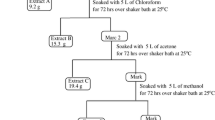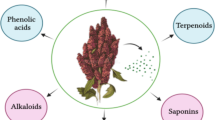Abstract
The present study aimed to identify and screen the antibacterial activity of a mixture of sesquiterpene lactones (SLs) obtained from the dichloromethane extract of Smallanthus sonchifolius leaves. Escherichia coli, Pseudomonas aeruginosa, Staphylococcus aureus, and Salmonella enterica strains were used as bacterial tests. The identification and quantification of compounds were established by GC/MS and 1H, 13C 2D NMR spectroscopic analysis. The antimicrobial activity was measured by the disk diffusion method and minimal inhibitory concentration assay (MIC). In vitro antimicrobial assays showed that the mixture of SLs found (uvedalin and enhydrin) displays poor antibacterial activity against the Gram-negative bacteria and appreciable antibacterial properties against the Gram-positive bacterial strain tested when 90 µg of the SLs mixture per disk was used. The MIC determination against S. aureus revealed that a concentration of 750 µg of SLs mixture mL−1 should be necessary to inhibit the strain. These results indicate that the SLs mixture of enhydrin and uvedalin from yacon leaves presents promising antibacterial properties against S. aureus and apparent lack of activity against the Gram-negative bacterial strains tested at the concentrations applied.

Similar content being viewed by others
References
Grau A, Rea J (1997) Smallanthus sonchifolius (Poepp. & Endl.) H. Robinson. In: Hermann M, Heller J (eds) Andean roots tubers Ahipa, arracacha, maca yacon. Promot. Conserv. use underutilized neglected Crop. 21. Institute of Plant Genetics and Crop Plant Research, Gatersleben, Germany/International Plant Genetic Resources Institute, Rome, Italy, pp 199–242
Ojansivu I, Ferreira CL, Salminen S (2011) Yacon, a new source of prebiotic oligosaccharides with a history of safe use. Trends Food Sci Technol 22:40–46. doi:10.1016/j.tifs.2010.11.005
de Andrade EF, de Souza Leone R, Ellendersen LN, Masson ML (2014) Phenolic profile and antioxidant activity of extracts of leaves and flowers of yacon (Smallanthus sonchifolius). Ind Crops Prod 62:499–506. doi:10.1016/j.indcrop.2014.09.025
Valentová K, Ulrichová J (2003) Smallanthus sonchifolius and Lepidium meyenii—prospective Andean crops for the prevention of chronic diseases. Biomed Pap 147:119–130. doi:10.5507/bp.2003.017
Oliveira RB, Chagas-Paula DA, Secatto A et al (2013) Topical anti-inflammatory activity of yacon leaf extracts. Braz J Pharmacogn 23:497–505. doi:10.1590/S0102-695X2013005000032
Lin F, Hasegawa M, Kodama O (2003) Purification and identification of antimicrobial sesquiterpene lactones from yacon (Smallanthus sonchifolius) leaves. Biosci Biotechnol Biochem 67:2154–2159. doi:10.1271/bbb.67.2154
Baroni S, da Rocha BA, Oliveira de Melo J et al (2016) Hydroethanolic extract of Smallanthus sonchifolius leaves improves hyperglycemia of streptozotocin induced neonatal diabetic rats. Asian Pac J Trop Med 9:432–436. doi:10.1016/j.apjtm.2016.03.033
Schmidt TJ (1999) Toxic activities of sesquiterpene lactones: structural and biochemical aspects. Curr Org Chem 3:577–608
Martino R, Beer MF, Elso O et al (2015) Sesquiterpene lactones from Ambrosia spp. are active against a murine lymphoma cell line by inducing apoptosis and cell cycle arrest. Toxicol Vitr 29:1529–1536. doi:10.1016/j.tiv.2015.06.011
De Ford C, Ulloa JL, Catalán CAN et al (2015) The sesquiterpene lactone polymatin B from Smallanthus sonchifolius induces different cell death mechanisms in three cancer cell lines. Phytochemistry 117:332–339. doi:10.1016/j.phytochem.2015.06.020
Merfort I (2002) Review of the analytical techniques for sesquiterpenes and sesquiterpene lactones. J Chromatogr A 967:115–130. doi:10.1016/S0021-9673(01)01560-6
Joung H, Kwon D-Y, Choi J-G et al (2010) Antibacterial and synergistic effects of Smallanthus sonchifolius leaf extracts against methicillin-resistant Staphylococcus aureus under light intensity. J Nat Med 64:212–215. doi:10.1007/s11418-010-0388-7
Inoue A, Tamogami S, Kato H et al (1995) Antifungal melampolides from leaf extracts of Smallanthus sonchifolius. Phytochemistry 39:845–848. doi:10.1016/0031-9422(95)00023-Z
Schorr K, Merfort I, da Costa FB (2007) A novel dimeric melampolide and further terpenoids from Smallanthus sonchifolius (Asteraceae) and the inhibition of the transcription factor NF-kB. Nat Prod Commun 2:367–374
Schorr K, Da Costa FB (2003) A proposal for chemical characterization and quality evaluation of botanical raw materials using glandular trichome microsampling of yacón (Polymnia sonchifolia, Asteraceae), an Andean medicinal plant. Braz J Pharmacogn 13:1–3. doi:10.1590/S0102-695X2003000300001
Genta SB, Cabrera WM, Mercado MI et al (2010) Hypoglycemic activity of leaf organic extracts from Smallanthus sonchifolius: constituents of the most active fractions. Chem Biol Interact 185:143–152. doi:10.1016/j.cbi.2010.03.004
Barcellona CS, Cabrera WM, Honoré SM et al (2012) Safety assessment of aqueous extract from leaf Smallanthus sonchifolius and its main active lactone, enhydrin. J Ethnopharmacol 144:362–370. doi:10.1016/j.jep.2012.09.021
Bauer AW, Kirby WM, Sherris JC, Turck M (1966) Antibiotic susceptibility testing by a standardized single disk method. Am J Clin Pathol 45:493–496
CLSI—Clinical and Laboratory Standards Institute (2006) Methods for dilution antimicrobial susceptibility tests for bacteria that grow aerobically. CLSI document M7-A7, 7th edn. Clinical and Laboratory Standards Institute, Wayne
Herz W, Bhat SV (1973) Maculatin: an isomer of uvedalin epoxide from Polymnia maculata. Phytochemistry 12:1737–1740. doi:10.1016/0031-9422(73)80394-2
Herz W, Bhat SV (1970) Isolation and structure of two new germacranolides from Polymnia uvedalia. J Org Chem 35:2605–2611. doi:10.1021/jo00833a028
Hong SS, Lee SA, Han XH et al (2008) Melampolides from the leaves of Smallanthus sonchifolius and their inhibitory activity of LPS-induced nitric oxide production. Chem Pharm Bull (Tokyo) 56:199–202. doi:10.1248/cpb.56.199
Ali E, Dastidar PPG, Pakrashi SC et al (1972) Studies on Indian medicinal plants—XXVIII. Tetrahedron 28:2285–2298. doi:10.1016/S0040-4020(01)93572-0
Mercado MI, Aráoz MVC, Grau A, Catalán CAN (2010) New acyclic diterpenic acids from yacon (Smallanthus sonchifolius) leaves. Nat Prod Commun 5:1721–1726
Aliyu AB, Moodley B, Chenia H, Koorbanally NA (2015) Sesquiterpene lactones from the aerial parts of Vernonia blumeoides growing in Nigeria. Phytochemistry 111:163–168. doi:10.1016/j.phytochem.2014.11.010
Wedge DE, Galindo JCG, Macı́as FA (2000) Fungicidal activity of natural and synthetic sesquiterpene lactone analogs. Phytochemistry 53:747–757. doi:10.1016/S0031-9422(00)00008-X
Giesbrecht AM, Davino SC, Nassis CZ et al (1990) Antimicrobial activity of sesquiterpene lactones. Quim Nova 13:312–314
Gershenzon J, Croteau R (1991) Terpenoids. In: Rosenthal GA, Berenbaum MR (eds) Herbivores: their interactions with secondary plant metabolites chemical participation, vol I Chemical Participation, 2nd edn. Academic, San Diego, pp 165–219
Calzada J, Ciccio JF, Echandi G (1980) Antimicrobial activity of the heliangolide chromolaenide and related sesquiterpene lactones. Phytochemistry 19:967–968
Cartagena E, Montanaro S, Bardon A (2008) Improvement of the antibacterial activity of sesquiterpene lactones. Rev Latinoam Química 36:43–51
Siriwan D, Naruse T, Tamura H (2011) Effect of epoxides and α-methylene-γ-lactone skeleton of sesquiterpenes from yacon (Smallanthus sonchifolius) leaves on caspase-dependent apoptosis and NF-κB inhibition in human cervical cancer cells. Fitoterapia 82:1093–1101. doi:10.1016/j.fitote.2011.07.007
Barrero AF, Oltra JE, Álvarez M et al (2000) New sources and antifungal activity of sesquiterpene lactones. Fitoterapia 71:60–64. doi:10.1016/S0367-326X(99)00122-7
Becker K, Heilmann C, Peters G (2014) Coagulase-negative staphylococci. Clin Microbiol Rev 27:870–926. doi:10.1128/CMR.00109-13
Pak A, Gonçalez E, Felicio JD et al (2006) Inhibitory activity of compounds isolated from Polymnia sonchifolia on aflatoxin production by Aspergillus flavus. Braz J Microbiol 37:199–203
Trombetta D, Castelli F, Sarpietro MG et al (2005) Mechanisms of antibacterial action of three monoterpenes. Antimicrob Agents Chemother 49:2474–2478. doi:10.1128/AAC.49.6.2474
Badawy MEI, Abdelgaleil SAM, Suganuma T, Fuji M (2014) Antibacterial and biochemical activity of pseudoguaianolide sesquiterpenes isolated from Ambrosia maritima against plant pathogenic bacteria. Plant Prot Sci 50:64–69
Zarai Z, Boujelbene E, Ben Salem N et al (2013) Antioxidant and antimicrobial activities of various solvent extracts, piperine and piperic acid from Piper nigrum. LWT Food Sci Technol 50:634–641. doi:10.1016/j.lwt.2012.07.036
Choi JG, Kang OH, Lee YS et al (2010) Antimicrobial activity of the constituents of Smallanthus sonchifolius leaves against methicillin-resistant Staphylococcus aureus. Eur Rev Med Pharmacol Sci 14:1005–1009
Acknowledgements
The authors gratefully acknowledge the Brazilian agencies CAPES (Coordination for Enhancement of Higher Education Personnel) and CNPq (National Council for Scientific and Technological Development) for the financial support.
Author information
Authors and Affiliations
Corresponding author
Ethics declarations
Conflict of interest
The authors declare that they have no conflict of interest.
Compliance with ethics requirements
This article does not contain any studies with human participants or animals performed by any of the authors.
Electronic supplementary material
Below is the link to the electronic supplementary material.
Rights and permissions
About this article
Cite this article
de Andrade, E.F., Carpiné, D., Dagostin, J.L.A. et al. Identification and antimicrobial activity of the sesquiterpene lactone mixture extracted from Smallanthus sonchifolius dried leaves. Eur Food Res Technol 243, 2155–2161 (2017). https://doi.org/10.1007/s00217-017-2918-y
Received:
Revised:
Accepted:
Published:
Issue Date:
DOI: https://doi.org/10.1007/s00217-017-2918-y




